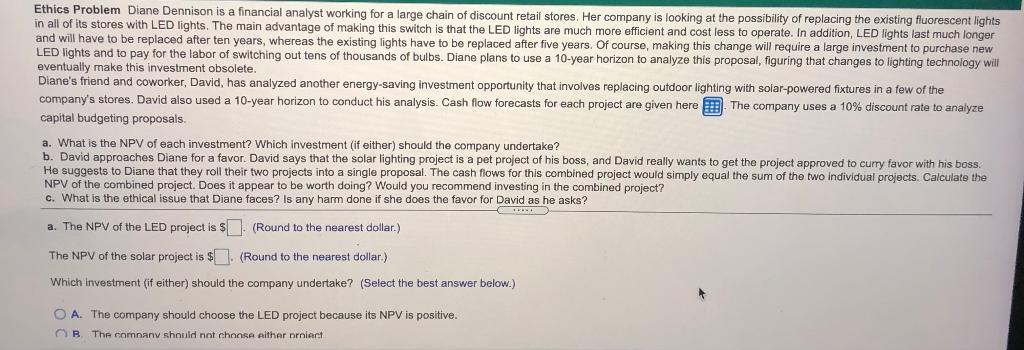
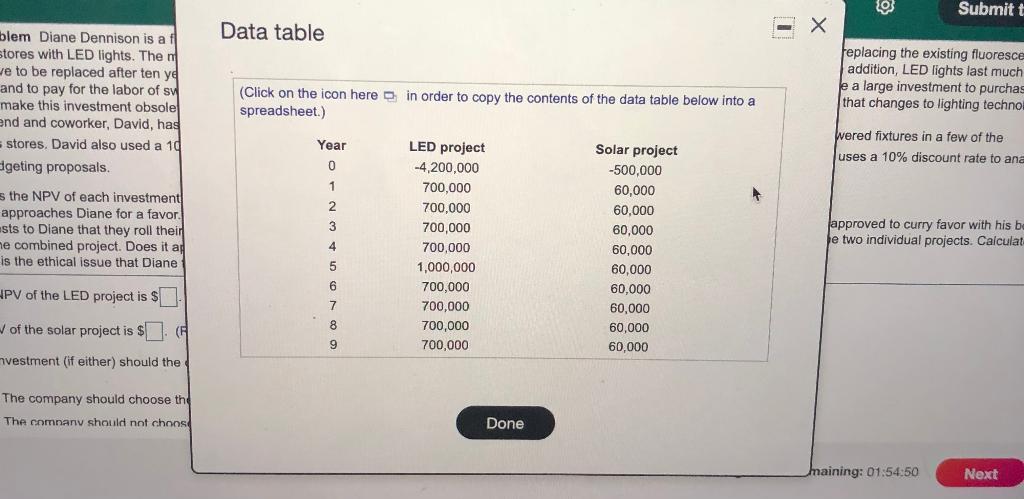
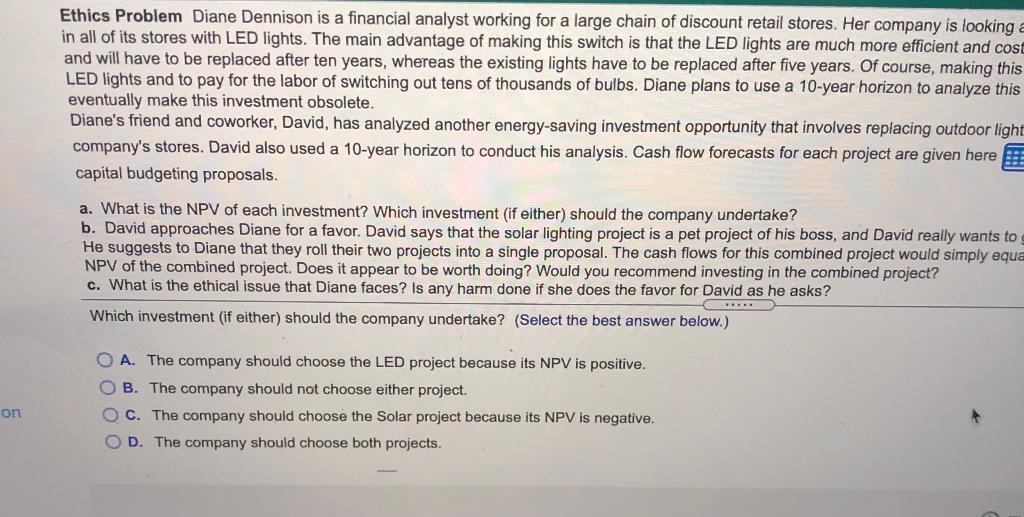

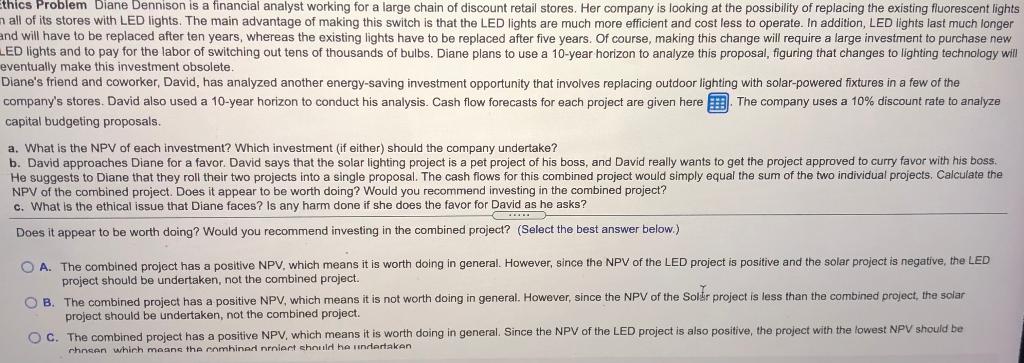
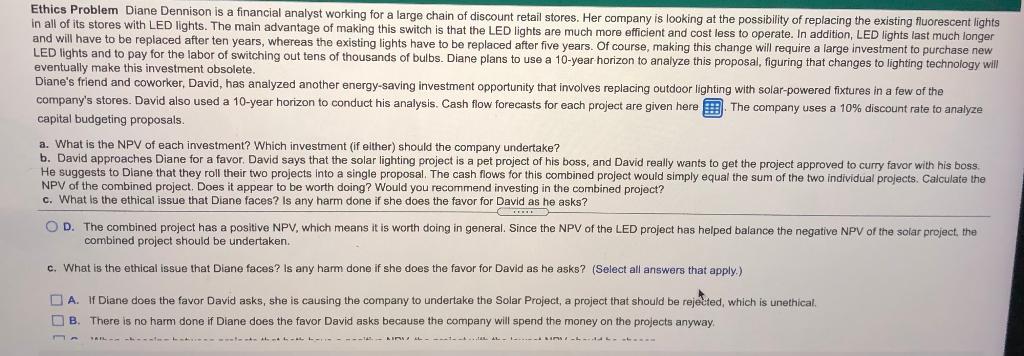
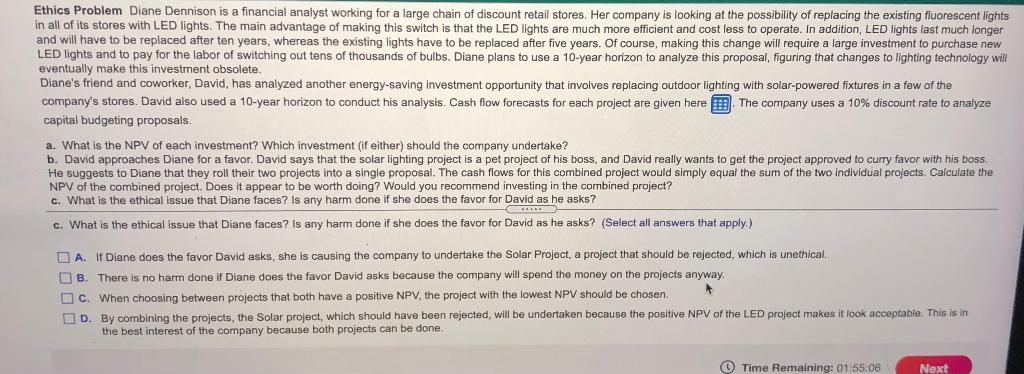
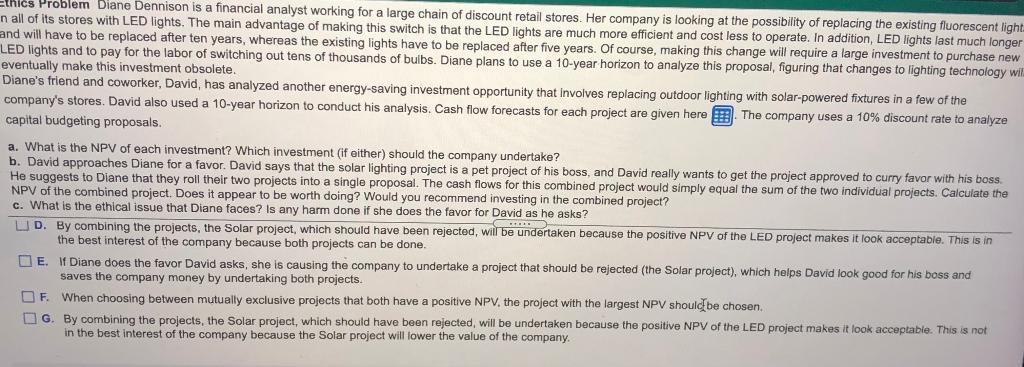
Ethics Problem Diane Dennison is a financial analyst working for a large chain of discount retail stores. Her company is looking at the possibility of replacing the existing fluorescent lights in all of its stores with LED lights. The main advantage of making this switch is that the LED lights are much more efficient and cost less to operate. In addition, LED lights last much longer and will have to be replaced after ten years, whereas the existing lights have to be replaced after five years. Of course, making this change will require a large investment to purchase new LED lights and to pay for the labor of switching out tens of thousands of bulbs. Diane plans to use a 10-year horizon to analyze this proposal, figuring that changes to lighting technology will eventually make this investment obsolete. Diane's friend and coworker, David, has analyzed another energy-saving investment opportunity that involves replacing outdoor lighting with solar powered fixtures in a few of the company's stores. David also used a 10-year horizon to conduct his analysis. Cash flow forecasts for each project are given here. The company uses a 10% discount rate to analyze capital budgeting proposals. a. What is the NPV of each investment? Which investment (if either) should the company undertake? b. David approaches Diane for a favor. David says that the solar lighting project is a pet project of his boss, and David really wants to get the project approved to curry favor with his boss. He suggests to Diane that they roll their two projects into a single proposal. The cash flows for this combined project would simply equal the sum of the two individual projects. Calculate the NPV of the combined project. Does it appear to be worth doing? Would you recommend investing in the combined project? c. What is the ethical issue that Diane faces? Is any harm done if she does the favor for David as he asks? a. The NPV of the LED project is $. (Round to the nearest dollar.) The NPV of the solar project is $. (Round to the nearest dollar.) Which investment (if either) should the company undertake? (Select the best answer below.) O A. The company should choose the LED project because its NPV is positive. B. The company should not choose either proiect Submitt Data table feplacing the existing fluoresce addition, LED lights last much le a large investment to purchas that changes to lighting techno (Click on the icon here in order to copy the contents of the data table below into a spreadsheet.) blem Diane Dennison is a f| stores with LED lights. Then Je to be replaced after ten ye and to pay for the labor of sw make this investment obsole end and coworker, David, has stores. David also used a 10 geting proposals. s the NPV of each investment approaches Diane for a favor. ests to Diane that they roll their me combined project. Does it a is the ethical issue that Diane Year wered fixtures in a few of the uses a 10% discount rate to ana 0 1 2 3 LED project -4,200,000 700,000 700,000 700,000 700,000 1,000,000 700,000 700,000 700,000 700,000 4 5 Solar project -500,000 60,000 60,000 60,000 60,000 60,000 60,000 60,000 60,000 60.000 approved to curry favor with his be Je two individual projects. Calculat HPV of the LED project is $ 6 7 8 9 of the solar project is $. nvestment (if either) should the The company should choose the The comnany should not choose Done maining: 01:54:50 Next Ethics Problem Diane Dennison is a financial analyst working for a large chain of discount retail stores. Her company is looking a in all of its stores with LED lights. The main advantage of making this switch is that the LED lights are much more efficient and cost and will have to be replaced after ten years, whereas the existing lights have to be replaced after five years. Of course, making this LED lights and to pay for the labor of switching out tens of thousands of bulbs. Diane plans to use a 10-year horizon to analyze this eventually make this investment obsolete. Diane's friend and coworker, David, has analyzed another energy-saving investment opportunity that involves replacing outdoor light company's stores. David also used a 10-year horizon to conduct his analysis. Cash flow forecasts for each project are given here capital budgeting proposals. a. What is the NPV of each investment? Which investment (if either) should the company undertake? b. David approaches Diane for a favor. David says that the solar lighting project is a pet project of his boss, and David really wants to He suggests to Diane that they roll their two projects into a single proposal. The cash flows for this combined project would simply equa NPV of the combined project. Does it appear to be worth doing? Would you recommend investing in the combined project? c. What is the ethical issue that Diane faces? Is any harm done if she does the favor for David as he asks? Which investment (if either) should the company undertake? (Select the best answer below.) .... O A. The company should choose the LED project because its NPV is positive. OB. The company should not choose either project. O C. The company should choose the Solar project because its NPV is negative. OD. The company should choose both projects. on Ethics Problem Diane Dennison is a financial analyst working for a large chain of discount retail stores. Her company is looking at the possibility of replaci in all of its stores with LED lights. The main advantage of making this switch is that the LED lights are much more efficient and cost less to operate. In additio and will have to be replaced after ten years, whereas the existing lights have to be replaced after five years. Of course, making this change will require a larg LED lights and to pay for the labor of switching out tens of thousands of bulbs. Diane plans to use a 10-year horizon to analyze this proposal, figuring that ch eventually make this investment obsolete. Diane's friend and coworker, David, has analyzed another energy-saving investment opportunity that involves replacing outdoor lighting with solar-powered fi company's stores. David also used a 10-year horizon to conduct his analysis. Cash flow forecasts for each project are given here. The company uses a 1 capital budgeting proposals. a. What is the NPV of each investment? Which investment (if either) should the company undertake? b. David approaches Diane for a favor. David says that the solar lighting project is a pet project of his boss, and David really wants to get the project approved He suggests to Diane that they roll their two projects into a single proposal. The cash flows for this combined project would simply equal the sum of the two indi NPV of the combined project. Does it appear to be worth doing? Would you recommend investing in the combined project? c. What is the ethical issue that Diane faces? Is any harm done she does the favor for David as he asks? b. The NPV of the combined project is $(Round to the nearest dollar.) Does it appear to be worth doing? Would you recommend investing in the combined project? (Select the best answer below.) on O A. The combined project has a positive NPV, which means it is worth doing in general. However, since the NPV of the LED project is positive and the solar pro project should be undertaken, not the combined project. O B. The combined project has a positive NPV, which means it is not worth doing in general. However, since the NPV of the Solar project is less than the combine project should be undertaken, not the combined project. thics Problem Diane Dennison is a financial analyst working for a large chain of discount retail stores. Her company is looking at the possibility of replacing the existing fluorescent lights n all of its stores with LED lights. The main advantage of making this switch is that the LED lights are much more efficient and cost less to operate. In addition, LED lights last much longer and will have to be replaced after ten years, whereas the existing lights have to be replaced after five years. Of course, making this change will require a large investment to purchase new LED lights and to pay for the labor of switching out tens of thousands of bulbs. Diane plans to use a 10-year horizon to analyze this proposal, figuring that changes to lighting technology will eventually make this investment obsolete. Diane's friend and coworker, David, has analyzed another energy-saving investment opportunity that involves replacing outdoor lighting with solar-powered fixtures in a few of the company's stores, David also used a 10-year horizon to conduct his analysis. Cash flow forecasts for each project are given here. The company uses a 10% discount rate to analyze capital budgeting proposals. a. What is the NPV of each investment? Which investment (if either) should the company undertake? b. David approaches Diane for a favor. David says that the solar lighting project is a pet project of his boss, and David really wants to get the project approved to curry favor with his boss He suggests to Diane that they roll their two projects into a single proposal. The cash flows for this combined project would simply equal the sum of the two individual projects. Calculate the NPV of the combined project. Does it appear to be worth doing? Would you recommend investing in the combined project? c. What is the ethical issue that Diane faces? Is any harm done if she does the favor for David as he asks? Does it appear to be worth doing? Would you recommend investing in the combined project? (Select the best answer below.) O A. The combined project has a positive NPV, which means it is worth doing in general. However, since the NPV of the LED project positive and the solar project is negative, the LED project should be undertaken, not the combined project. OB. The combined project has a positive NPV, which means it is not worth doing in general. However, since the NPV of the Solr project is less than the combined project, the solar project should be undertaken, not the combined project. OC. The combined project has a positive NPV, which means it is worth doing in general. Since the NPV of the LED project is also positive, the project with the lowest NPV should be rhnson which means the combined nolent should he rindertaken Ethics Problem Diane Dennison is a financial analyst working for a large chain of discount retail stores. Her company is looking at the possibility of replacing the existing fluorescent lights in all of its stores with LED lights. The main advantage of making this switch is that the LED lights are much more efficient and cost less to operate. In addition, LED lights last much longer and will have to be replaced after ten years, whereas the existing lights have to be replaced after five years. Of course, making this change will require a large investment to purchase new LED lights and to pay for the labor of switching out tens of thousands of bulbs. Diane plans to use a 10-year horizon to analyze this proposal, figuring that changes to lighting technology will eventually make this investment obsolete. Diane's friend and coworker, David, has analyzed another energy-saving investment opportunity that involves replacing outdoor lighting with solar-powered fixtures in a few of the company's stores. David also used a 10-year horizon to conduct his analysis. Cash flow forecasts for each project are given here. The company uses a 10% discount rate analyze capital budgeting proposals. a. What is the NPV of each investment? Which investment (if either) should the company undertake? b. David approaches Diane for a favor. David says that the solar lighting project is a pet project of his boss, and David really wants to get the project approved to curry favor with his boss. He suggests to Dlane that they roll their two projects into a single proposal. The cash flows for this combined project would simply equal the sum of the two individual projects. Calculate the NPV of the combined project. Does it appear to be worth doing? Would you recommend investing in the combined project? c. What is the ethical issue that Diane faces? Is any harm done if she does the favor for David as he asks? OD. The combined project has a positive NPV, which means it is worth doing in general. Since the NPV of the LED project has helped balance the negative NPV of the solar project, the combined project should be undertaken. c. What is the ethical issue that Diane faces? Is any harm done if she does the favor for David as he asks? (Select all answers that apply.) A. I Diane does the favor David asks, she is causing the company to undertake the Solar Project, a project that should be rejetted, which is unethical, B. There is no harm done if Diane does the favor David asks because the company will spend the money on the projects anyway AL-------------------------...IL ALL- Ethics Problem Diane Dennison is a financial analyst working for a large chain of discount retail stores. Her company is looking at the possibility of replacing the existing fluorescent lights in all of its stores with LED lights. The main advantage of making this switch is that the LED lights are much more efficient and cost less to operate. In addition, LED lights last much longer and will have to be replaced after ten years, whereas the existing lights have to be replaced after five years. Of course, making this change will require a large investment to purchase new LED lights and to pay for the labor of switching out tens of thousands of bulbs. Diane plans to use a 10-year horizon to analyze this proposal, figuring that changes to lighting technology will eventually make this investment obsolete. Diane's friend and coworker, David, has analyzed another energy-saving investment opportunity that involves replacing outdoor lighting with solar-powered fixtures in a few of the company's stores. David also used a 10-year horizon to conduct his analysis. Cash flow forecasts for each project are given here. The company uses a 10% discount rate to analyze capital budgeting proposals, a. What is the NPV of each investment? Which investment (if either) should the company undertake? b. David approaches Diane for a favor. David says that the solar lighting project is a pet project of his boss, and David really wants to get the project approved to curry favor with his boss, He suggests to Diane that they roll their two projects into a single proposal. The cash flows for this combined project would simply equal the sum of the two individual projects. Calculate the NPV of the combined project. Does it appear to be worth doing? Would you recommend investing in the combined project? c. What is the ethical issue that Diane faces? Is any harm done if she does the favor for David as he asks? nude c. What is the ethical issue that Diane faces? Is any harm done if she does the favor for David as he asks? (Select all answers that apply.) A. If Diane does the favor David asks, she is causing the company to undertake the Solar Project, a project that should be rejected, which is unethical B. There is no harm done if Diane does the favor David asks because the company will spend the money on the projects anyway C. When choosing between projects that both have a positive NPV, the project with the lowest NPV should be chosen D. By combining the projects, the Solar project, which should have been rejected, will be undertaken because the positive NPV of the LED project makes it look acceptable. This is in the best interest of the company because both projects can be done. Time Remaining: 01:55:06 Next thics Problem Diane Dennison is a financial analyst working for a large chain of discount retail stores. Her company is looking at the possibility of replacing the existing fluorescent light n all of its stores with LED lights. The main advantage of making this switch is that the LED lights are much more efficient and cost less to operate. In addition, LED lights last much longer and will have to be replaced after ten years, whereas the existing lights have to be replaced after five years. Of course, making this change will require a large investment to purchase new LED lights and to pay for the labor of switching out tens of thousands of bulbs. Diane plans to use a 10-year horizon to analyze this proposal, figuring that changes to lighting technology wil eventually make this investment obsolete. Diane's friend and coworker, David, has analyzed another energy-saving investment opportunity that involves replacing outdoor lighting with solar-powered fixtures in a few of the company's stores. David also used a 10-year horizon to conduct his analysis. Cash flow forecasts for each project are given here. The company uses a 10% discount rate to analyze capital budgeting proposals. a. What is the NPV of each investment? Which investment (if either) should the company undertake? b. David approaches Diane for a favor. David says that the solar lighting project is a pet project of his boss, and David really wants to get the project approved to curry favor with his boss. He suggests to Diane that they roll their two projects into a single proposal. The cash flows for this combined project would simply equal the sum of the two individual projects. Calculate the NPV of the combined project. Does it appear to be worth doing? Would you recommend investing in the combined project? c. What is the ethical issue that Diane faces? Is any harm done if she does the favor for David as he asks? UD. By combining the projects, the Solar project, which should have been rejected, will be undertaken because the positive NPV of the LED project makes it look acceptable. This is in the best interest of the company because both projects can be done. E. I Diane does the favor David asks, she is causing the company to undertake a project that should be rejected (the Solar project), which helps David look good for his boss and saves the company money by undertaking both projects. F. When choosing between mutually exclusive projects that both have a positive NPV, the project with the largest NPV should be chosen G. By combining the projects, the Solar project, which should have been rejected, will be undertaken because the positive NPV of the LED project makes it look acceptable. This is not in the best interest of the company because the Solar project will lower the value of the company. DO














